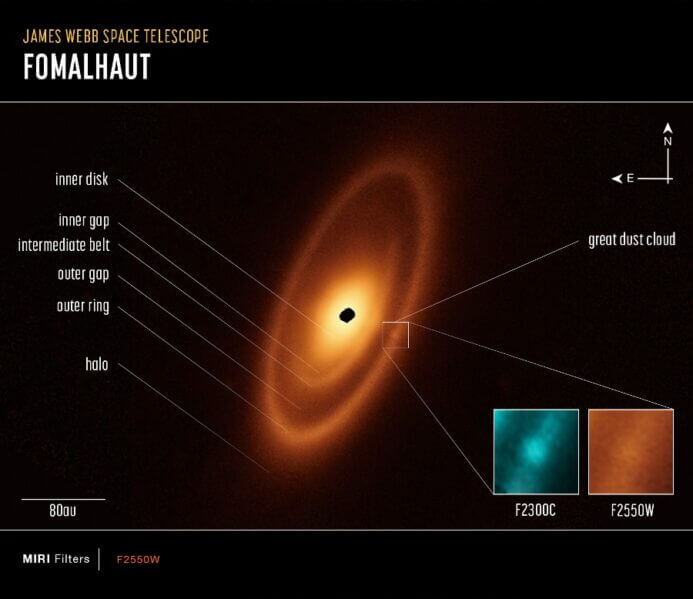Key Points
- NASA’s James Webb Space Telescope captures first-ever infrared images of an asteroid belt beyond our solar system around star Fomalhaut.
- The dust structure is three-fold and more complex than our solar system’s dust belts, hinting at unseen planets.
- The new findings provide unique insights into the structure of an exoplanetary system, down to earth-sized planets and asteroids.
Astro-boffins wielded NASA’s James Webb Space Telescope to snap some hot shots of the dusty surrounds of a young, nearby star, Fomalhaut. They were hoping to get a squiz at the first asteroid belt ever seen outside our solar system in infrared light. But what they found was more than just a posh asteroid belt; it was an entire dust wardrobe!
Fomalhaut, a star bright enough to be seen with the naked eye in the southern constellation Piscis Austrinus, is surrounded by three dusty belts, a debris collection from the smash-ups of bigger bodies similar to our own asteroids and comets. Fomalhaut is the archetype of debris disks found elsewhere in our galaxy, because it has components similar to those we have in our own planetary system, said András Gáspár of the University of Arizona in Tucson and lead author of the paper detailing these findings. By looking at the patterns in these rings, we can start to make a little sketch of what a planetary system ought to look like – if we could actually take a deep enough picture to see the suspected planets, he believes.
Previously, the Hubble Space Telescope and other instruments had managed to take sharp photos of Fomalhaut’s outermost belt, but the inner belts had remained elusive. Enter the James Webb Space Telescope with its infrared prowess. “Where Webb really excels is that we’re able to physically resolve the thermal glow from dust in those inner regions. So you can see inner belts that we could never see before,” said Schuyler Wolff, another star-gazer from the University of Arizona.
The orbital paths in these belts are likely shaped by the gravitational forces of unseen planets, just like in our solar system. As we continue to capture images of more systems, we’ll learn more about their planets’ configurations.
The existence of Fomalhaut’s dust ring has been known since 1983, thanks to observations made by NASA’s Infrared Astronomical Satellite (IRAS). “The belts around Fomalhaut are kind of a mystery novel: Where are the planets?” questioned George Rieke, another member of the research team. “I think it’s not a very big leap to say there’s probably a really interesting planetary system around the star.”
Wolff added, “We definitely didn’t expect the more complex structure with the second intermediate belt and then the broader asteroid belt. Any time an astronomer sees a gap and rings in a disk, they say, ‘There could be an embedded planet shaping the rings!’”
Webb also spotted what Gáspár calls “the great dust cloud,” possibly the aftermath of a collision in the outer ring between two protoplanetary bodies. This feature is different from a suspected planet first spotted inside the outer ring by Hubble in 2008, which seemed to have disappeared by 2014. The reasonable explanation is that both features are expanding clouds of fine dust particles from two icy bodies that had a bit of a bust-up.
The concept of a protoplanetary disk around a star was first proposed back in the late 1700s by astronomers Immanuel Kant and Pierre-Simon Laplace. After planets form, these disks transition into debris disks, showing that smaller bodies like asteroids are having a bit of a tumble, leading to enormous clouds of dust and debris. Observing their dust can give us special insights into the structure of an exoplanetary system, down to earth-sized planets and even asteroids, which are usually too tiny to spot.
The results of these cosmic revelations have been published in the journal Nature Astronomy, for all the space-keen kids out there.
The James Webb Space Telescope is the world’s top dog for space science observation. Fomalhaut’s observation employed the Mid-Infrared Instrument (MIRI), a joint venture of NASA and ESA (European Space Agency), built by a consortium of nationally funded European Institutes and NASA’s Jet Propulsion Laboratory, in partnership with the University of Arizona. Webb is set to solve cosmic mysteries, peer into distant worlds around other stars, and explore the mysterious structures and origins of our universe and our place in it.
For more information about Webb, visit the NASA website: https://www.nasa.gov/webb.


